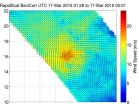(Press-News.org) Researchers at the San Diego Supercomputer Center (SDSC) and the Moores Cancer Center at the University of California, San Diego, have described for the first time the molecular mechanism of cancer development caused by well-known "resistance" mutations in the gene called epidermal growth factor receptor (EGFR).
While these mutations were known for quite a long time, the question as to why they cause cancer or make some drugs ineffective was still not answered.
The study, called "Molecular Determinants of Drug-Specific Sensitivity for Epidermal Growth Factor Receptor (EGFR) Exon 19 and 20 Mutants in Non-Small Cell Lung Cancer," and published online in the journal Oncotarget, demonstrates how computer modeling of EGFR mutations found in lung cancer can elucidate their molecular mechanism of action and consequently optimize the selection of therapeutic agents to treat patients.
On the basis of structural analysis of this protein, scientists demonstrated that specific mutations within the EGFR gene increase electrostatic interactions between the two dimer subunits of EGFR, stabilizing it in an "active" state, leading to cancer. Such a finding suggested that the treatment of EGFR-related lung cancers with the usual small molecule inhibitory drugs would not be successful (patients harboring these mutations are typically resistant to these drugs), while antibodies that interfere with dimerization of EGFR would be effective.
"The mutations are substitutions of one amino acid to another, or a set of neighboring amino acids to a different set of them," said lead author Igor F. Tsigelny, a research scientist with the SDSC as well as the UC San Diego Moores Cancer Center and the Department of Neurosciences. "The proteins have mechanisms of adaptations for possible mutations, and in many cases the proteins survive and can fulfill some of their function. At the same time, some important changes can happen. For example, the protein can became permanently active, and such activity would lead to overgrowth of cells and eventually to cancer."
Tsigelny added: "The clinical treatments that do not take into consideration the specific mutations in genes, but rather treat all mutations within a specific gene such as EGFR as the same, are a 'hit-or-miss' game because they are based solely on observational data on how other patients previously have reacted to drug therapies."
This study is also important because it explains why some new mutations in EGFR - which are acquired during the course of treatment of lung cancer with small molecule EGFR inhibitors such as erlotinib - lead to drug resistance and patient death.
"The body doesn't recognize tumors as harmful, but instead treats them like normal organs that need protection," said Tsigelny. "This drives the development of mutations that cause drug resistance."
Ready-Made Treatments
Moreover, new drugs are being developed to treat the resistant mutations, but the specific ones studied in this paper have not been amenable to therapy with these new drugs. Instead, the study showed that an existing drug (an antibody that targets EGFR) could be used, indicating that there may be a ready-made treatment available.
The modeling predictions are consistent with the clinical results. Two patients with the specific resistance mutation analyzed achieved partial remissions when treated with a regimen that included the EGFR antibody cetuximab, as predicted by the computer-based structural modeling. One patient continues to do well more than 3.5 years later.
"These studies form a proof-of-principle demonstration of the ability of computer modeling to be used to choose therapy for individuals," said Razelle Kurzrock, senior deputy director (clinical science) and director of the Center for Personalized Cancer Therapy at UCSD Moores Cancer Center, and senior author of this paper. "Further investigation in larger patient groups is needed."
Both Tsigelny and Kurzrock agreed that this finding is an excellent example of the power of collaboration between SDSC and the Moores Cancer Center, and that such modeling needed to be studied across tumors and with multiple different genes involved in cancer.
INFORMATION:
In addition to Tsigelny and Kurzrock, researchers involved in the study include Valentina L. Kouznetsova from SDSC and the Moores Cancer Center; Jerry P. Greenberg from SDSC; Lyudmila Bazhenova from the Moores Cancer Center; Jennifer J. Wheler from M.D. Anderson Cancer Center; and David J. Stewart from the University of Ottawa.
Financial support for the study was provided in part by the Joan and Irwin Jacobs Fund.
Tropical Cyclone Bavi weakened to a depression and NASA's RapidScat instrument measured its waning winds from space.
On March 17 the RapidScat instrument aboard the International Space Station (ISS) measured Bavi's surface winds from 01:28 to 3:01 UTC. RapidScat data showed surface winds were strongest winds in the northwestern quadrant. Sustained winds were near 17 m/s (38 mph/61 kph) and weaker around the rest of the storm.
On March 18 at 0000 UTC (March 17 at 8 p.m. EDT), the Joint Typhoon Warning Center noted that Bavi's maximum sustained winds dropped to 25 knots ...
Cambridge, Mass. - March 17, 2015 - The velvet worm is a slow-moving, unassuming creature. With its soft body, probing antennae, and stubby legs, it looks like a slug on stilts as it creeps along damp logs in tropical climates.
But it has a secret weapon. In the dark of night, when an unsuspecting cricket or termite crosses its path, the worm unleashes an instantaneous torrent of slime. Two fine jets of the gluey substance spray out of openings on its head, oscillating in all directions to cast a sticky net that entraps prey and stops it in its tracks.
Captivated, ...
While unconscious race and social class biases were present in most trauma and acute-care clinicians surveyed about patient care management in a series of clinical vignettes, those biases were not associated with clinical decisions, according to a report published online by JAMA Surgery.
Disparities in the quality of care received by minority patients have been reported for decades across multiple conditions, types of care and institutions, according to the study background. Adil H. Haider, M.D., M.P.H., of Brigham and Women's Hospital, Boston, conducted a web-based survey ...
ANN ARBOR, Mich. - Drugs aimed at quelling the behavior problems of dementia patients may also hasten their deaths more than previously realized, a new study finds.
The research adds more troubling evidence to the case against antipsychotic drugs as a treatment for the delusions, hallucinations, agitation and aggression that many people with Alzheimer's disease and other dementias experience.
In the new issue of the journal JAMA Psychiatry, researchers report findings from nearly 91,000 American veterans over the age of 65 with dementia.
Data from each patient who ...
TORONTO (March 18, 2015) - People with a severe form of schizophrenia have major differences in their brain networks compared to others with schizophrenia, bipolar disorder and healthy individuals, a new study from the Centre for Addiction and Mental Health (CAMH) shows.
The study, which used a novel approach to map brain networks, was led by researchers at the Campbell Family Mental Health Research Institute at CAMH and published in this week's JAMA Psychiatry.
"Finding ways to help this particular group of people with schizophrenia is a priority as recovery is ...
COLLEGE STATION - A ground-breaking Texas A&M AgriLife Research-led study on corn has identified useful gene variations for yield increases, drought tolerance and aflatoxin resistance that could make a real difference to Texas producers in the years to come, according to researchers.
The study, titled "Genome Wide Association Study for Drought, Aflatoxin Resistance, and Important Agronomic Traits of Maize Hybrids in the Sub-Tropics" was recently published in PLOS ONE, an international, peer-reviewed, open-access, online publication.
The study included the growing years ...
From computers, tablets, and smartphones to cars, homes, and public transportation, our world is more digitally connected every day. The technology required to support the exchange of massive quantities of data is critical. That's why scientists and engineers are intent on developing faster computing units capable of supporting much larger amounts of data transfer and data processing.
A new study published in Nature Photonics by Tel Aviv University researchers finds that new optical materials could serve as the nuts and bolts of future ultra-high-speed optical computing ...
TORONTO, March 18, 2015--Researchers have defined a new bodily process in mice that may explain why blood oxygen levels are lower for patients with cystic fibrosis when they get a lung infection.
"Infected areas of the lung are not as capable as healthy tissue at adding oxygen to the bloodstream, but no one has shown why this is the case," said Dr. Wolfgang Kuebler, a scientist in the Keenan Research Centre for Biomedical Science of St. Michael's Hospital. "We've shown that the protein produced by a gene known as CFTR is required to direct blood flow away from infected ...
This news release is available in Spanish. Using discarded electronic boards, the UPV/EHU researcher Andoni Salbidegoitia has, in collaboration with international researchers, developed a system for obtaining clean hydrogen that can be used as fuel. The researchers have already registered the patent of the process in Japan.
The Chemical Technologies for Environmental Sustainability (TQSA) Group of the Department of Chemical Engineering of the UPV/EHU's Faculty of Science and Technology is aiming to make use of discarded plastic as effectively as possible from the ...
Bats are not as stereotyped when they hunt as previously believed. New research shows that these flying mammals are capable of making ultra-fast decisions about how to attack their prey - or maybe even call off the attack. It takes only milliseconds.
Bats use echolocation for orientation. They emit ultrasonic sounds, which hit potential prey nearby, sending an echo back to the bat. From this echo the bat can define where the prey is and attack it. A new study has examined how hunting bats react when approaching their prey. The study concludes that bats are capable of ...



